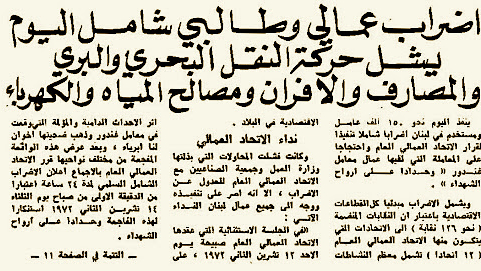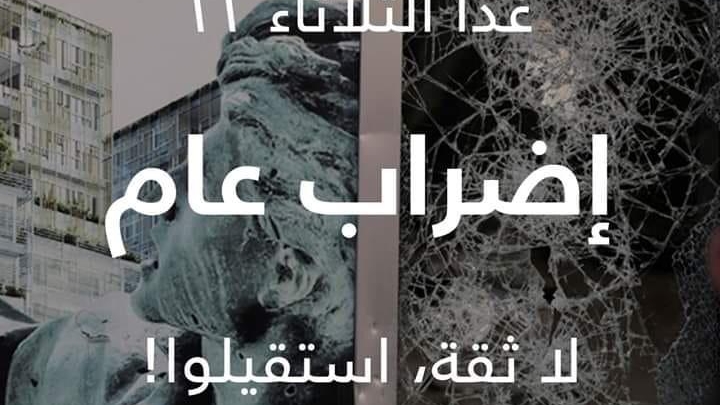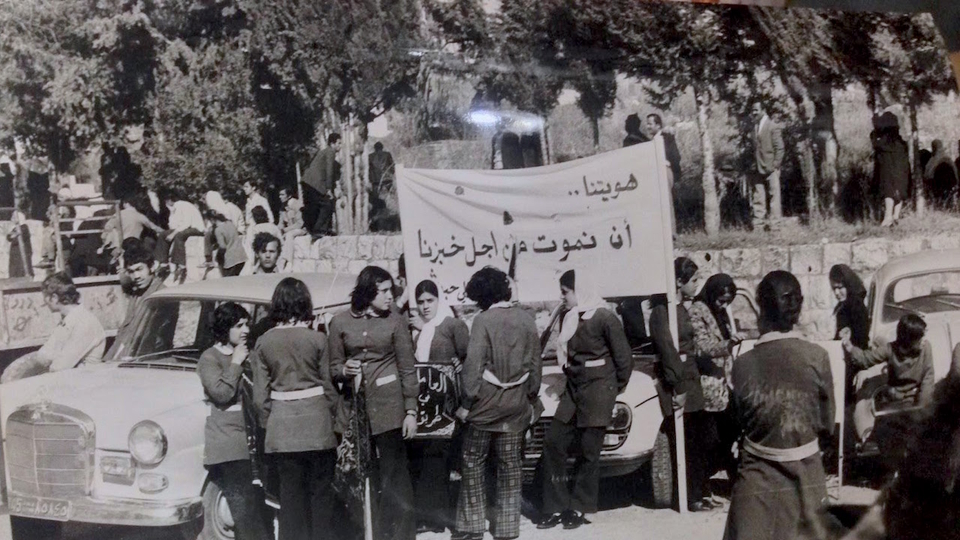The Power of Withholding Labor: The General Strike as Cultural Work
Day 412: Tuesday, December 1, 2020
Saad Hariri is prime minister again. The August 4 port crime is gradually followed by smaller disasters and critical COVID-19 cases are mounting. It feels like variations of a theme, a calculated disaster on repeat, even as the variations have become more blunt and deadly.
Back in April, when Fawaz al-Samman was shot by the Lebanese army, I was overcome with rage at these repetitions, at the tragic, familiar scenario of a young protestor and father, brother, partner, comrade killed as he demanded a just political system and the ability to live. Posters circulated referring to him as “Martyr of the Hunger Revolution.” I remembered a photograph I had found from an unidentified protest in the 1970s in which young women in factory uniforms held a banner that read “our identity is to die for our bread.” I was troubled by the parallels in these slogans. Both contain narratives of working-class expendability, inevitability, the glory of martyrdom. The link is subtle, but persistent (even as protesters push back at the narrative, such as social media posts insisting the August 4 blast victims are not martyrs).
What about the other slogan of the labor movement, “bread and roses,” famously associated with a majority-women mill workers’ strike, many of whom were recent immigrants from Greater Syria, in Lawrence, USA, in 1912? Mutual care: singing, sharing food, simultaneously translated meetings and worker-organized childcare were all pivotal to the strike’s success. And so their banners repeated a popular song, “hearts starve as well as bodies; give us bread, but give us roses!” These are important differences in narration that reflect powerfully on strategy and tactics of struggle. They have real impacts on lives. No one struggles to die for their bread, but rather to live.
Narratives about the inevitability of working-class deaths are not of our making. Rather, these frameworks are central to global capitalism, and key to Lebanon’s neo-feudal neoliberalism. The COVID-19 pandemic has made this blaringly obvious, as something called “the economy” is falsely opposed to health, and the language of tradeoffs, risk-analysis, balancing ours and others’ potential deaths is presented as a natural way to make decisions and to live. In opposing these systems and dynamics, it is more essential than ever that our own modes of resistance do not echo these narratives, that they instead dream, imagine, open different horizons.
Amidst today’s widespread anger, frustration, and demoralization, revisiting the general strike as a generative political and cultural practice can create space for different frames of representation and action.The October revolution promised, and in many ways delivered, a break from this repetition. This reimagining is represented no more clearly than by the reinvigorated general strike, which substantively reinserted labor into mass politics. Amidst today’s widespread anger, frustration, and demoralization, revisiting the general strike as a generative political and cultural practice can create space for different frames of representation and action.
The General Strike: A Local History
Beginning on October 21, 2019, and repeating through the following months, the general strike became an important — if previously unfathomable — feature of Lebanese politics. In late 2019 and early 2020, the strike was observed intermittently by teachers, students, public sector employees and cultural institutions, telecom and banking sectors that scored partial victories. Despite never being comprehensive, it was accompanied by road closures that at least temporarily shut down business as usual. Before October 2019, the general strike — in which every worker in every sector participates, paralyzing the economy and forcing the hand of the ruling class — felt like a distant dream: romantically effective, but in the context of post-war labor movement demobilization, impossible to imagine.

An-Nahar newspaper on the November 13, 1972, general strike in Lebanon.
But this was not always the case: the general strike has been a powerful tool in twentieth-century Lebanon. In May 1946, in the early years of Lebanese independence, tobacco workers, mostly women, led a strike at the “Regie,” a French-Lebanese company that monopolized the tobacco industry. Warde Butros Ibrahim, a 19-year-old worker who was active in the strike was killed by the Lebanese army. A broad coalition of burgeoning union federations threatened a general strike across the public sector,1 which led the Regie to negotiate with the workers and built the momentum needed to pass the, albeit weak, Lebanese Labor Law. In November 1972, a general strike bore fruit again. Striking workers at Gandour & Sons Confectionary factory were again violently repressed, resulting in two deaths.2 A comprehensive national strike pressured the company to reinstate the workers who had been fired, and eventually led to small improvements in labor legislation.
This “common sense” had begun to change globally two decades later. In February 1996, the General Confederation of Lebanese Trade Unions (CGTL), then a significant independent labor force, called for a general strike in response to Rafiq Hariri’s economic vision, mounting public debt, and falling wages.3 The threat of the strike and of a reinvigorated labor movement’s potential to curtail Hariri’s reconstruction regime of privatization and wealth-concentration, obviously scared his administration. Hariri resorted to drastically effective measures, declaring a three-month ban on demonstrations and an army-enforced curfew. The CGTL called off the strike at the last minute, a historical turning point that ultimately supported Hariri’s campaign to obliterate the labor movement’s leverage.
[T]he hauntingly empty streets of Beirut and Tripoli from that moment convey the power of our collectively withheld labor, images even more evocative than those of our packed squares in times of political protest.Hariri succeeded in defanging the trade union movement, capitalizing on post-war exhaustion and mutual sectarian mistrust. We are still enduring the consequences of this episode, which all but eliminated meaningful labor-based solidarity from our movements. Still, I would hold that the hauntingly empty streets of Beirut and Tripoli from that moment convey the power of our collectively withheld labor, images even more evocative than those of our packed squares in times of political protest.
General Strike as Form
Each of these strikes occurred in a political-cultural landscape where the strike was a common and accessible instrument of action — unlike today. In the historical instances above, cross-industry strikes that could halt the country’s productive industries were coordinated through labor federations, whereas today’s economic landscape has changed. Lebanese industry is negligible at best, and the wealth of the feudal elite lies more in real estate and finance capital than production. Alongside today’s increasingly racially-segregated and precarious labor force, the ruling class is better insulated from the general strike’s once crippling effects.
Yet in such circumstances, the general strike could rapidly change the horizon of action as it had historically. Herein lies its magic. As Rosa Luxembourg argued over a century ago, the general strike can serve as the means for creating “the conditions of the daily political struggle."4 Paradoxically, the strike serves to suddenly unsettle the status quo, coalescing common sentiment into action.
- 1Abisaab, Malek Hassan. 2004. “"Unruly" Factory Women in Lebanon: Contesting French Colonialism and the National State, 1940-1946” Journal of Women's History, Volume 16, Number 3, Fall 2004, pp. 55-82
- 2See my film "A Feeling Greater Than Love" (2017) for a nuanced version of this story.
- 3Baroudi, S. (1998). “Economic Conflict in Postwar Lebanon: State-Labor Relations between 1992 and 1997.” The Middle East Journal, 52(4), 531–550.
- 4Luxembourg, Rosa. The Mass Strike. 1905.

Announcing the second day of the open-ended strike that began on Monday, October 21, 2019.
In tune with this logic, the call for a general strike on October 21, 2019 was not attached to one group, figure or union. Multiple active organizers I spoke with reflected that it just “seemed like the logical next step.” Media outlets also reported on the call for a strike as multi-sourced. Although I may find a story of origins if I research the question further,1 I would like to suggest that, like other effective mass movements, the general strike came together after decades of impossibility because it made sense to many and different people at the same time. In this sense, it becomes possible to consider the general strike as a collective performance.
It is exactly this nexus of collective cultural acts and popular political practice that might give us something to look towards, amidst the current exhaustion, rage, and difficulty of imagination. Reviving that kind of collective-cultural-political transformative work is essential in this moment of overwhelming despair.
“The force of performance,” queer and cultural theorist José Esteban Muñoz observed, is “the ability to generate a modality of knowing and recognition among audiences and groups that facilitates modes of belonging.”2
The strike as performance shifted modes of belonging towards class identification.3
The practice of together withholding our labor allowed us to think about the power that labor has in maintaining the system as it is, and to grasp its collective potential. It forces those of us who rely on a wage to see ourselves as workers (albeit of with widely varying conditions).4
Further, the notion that effective political praxis is not dependent on precise theory or slick communication, but rather must be wildly collective to work is a drastic shift from the party and personality-led politics that has dominated in recent decades. This narrative shift in our view of political economy, and our relation to it is enormous. It is at its core a cultural work with profound political implications. It is exactly this nexus of collective cultural acts and popular political practice that might give us something to look towards, amidst the current exhaustion, rage, and difficulty of imagination. Reviving that kind of collective-cultural-political transformative work is essential in this moment of overwhelming despair.
Political Work as Cultural Work
Cultural work is always political.5 As producers of cultural works, from written text to dance and cinema, our decisions, materials, references, language, and funding sources have profound impacts on the kinds of narratives we engage with, uphold, or challenge, even if these decisions are not fully conscious. These in turn impact how our work is received, what it does as it circulates in the world.
But politics, in turn, is also cultural work. The most effective repressive politicians know this well, as they play on existing frames like sectarianism to achieve material ends. Politics functions both at the level of material action (say building, or blocking a dam) and at the level of meaning and representation (the narrative that mega dams increase water access vs that they have immeasurable repercussions on livelihoods and ecologies). The kinds of material consequences we are willing to put up with, which economists call these “trade-offs,” and how we interpret them depends largely on our cultural frames that are always shifting. As Stuart Hall reminds us, cultural work is an important site of struggle. This is not only a dictum to produce subversive popular culture, but also to center the interplay between political and cultural work in creating the “possibilities of new subjectivities.”6 Creating new subjectivities, or ways of being together in the world, is exactly the substance of political change we need in times when everything seems bleak.
Such an expansive definition of cultural work allows us to see acts of solidarity and collectivity for their transgressive potential. Cultural works like the 2019-2020 general strike open up new paths and possibilities. Another example occurred in the immediate aftermath of August 4 when the Civic Defense refused to deploy their trucks against demonstrators demanding accountability. Moved by the criminal loss of their comrades days earlier, these civil servants briefly incorporated civil disobedience to the repertoire of dissent. Later in January 2020, women also performed cultural work when “The Women’s Front line” stood between the army and other protesters, insisting that violent escalation was strategically detrimental to the moment (and not only that “as women” they were “intrinsically peaceful”). All these works defy any one person or group’s claim to authorship.
Documentation alone cannot convince those who still do not acknowledge the system’s violence, or those who, while desiring change do not see an alternative to entrenched realities of colonial and feudal dependency. We need to disrupt and transform our relation to those histories with a vastly different logic, through political and cultural work alike. But how?
When we shift our frame in this way, it becomes possible to think of cultural production in the more traditional sense as capable of amplifying, echoing, making possible, and opening spaces for these and other kinds of cultural practices to multiply. I am not only referring to dedicated cultural groups producing work to support the struggle.7
This is essential work, like work that processes trauma. Yet, if the revolutions since 2010 have shown us anything, it is that art which documents political violence, celebrates mass gathering, or tracks individual character transformations through a stagnating political situation remains insufficient to bring about change. Documentation — certainly has its uses for future aspirational war crimes trials and for rallying outside opinions — but alone cannot convince those who still do not acknowledge the system’s violence, or those who, while desiring change do not see an alternative to entrenched realities of colonial and feudal dependency. We need to disrupt and transform our relation to those histories with a vastly different logic, through political and cultural work alike. But how?
Amidst this uncertainty, I’d like to imagine the implications of the general strike as form. What would inserting the strike’s insistence on our mutual dependence do to the shape and process of more traditional cultural work? What would art become if we strove to be as widely comprehensive and functionally inclusive as the general strike’s most utopian aspiration? What would art become if we also took seriously the general strike’s critics who insist that the comprehensive strike must also involve reproductive and care work, that is, the Women’s Strike8 ? To begin with, it would mean embracing the notion that no artistic work is entirely self-authored. It would do away with the myth of artistic genius.9 It could also mean reorienting art-making and circulation along the principles of care and solidarity.
Romanian film journalist Diana Mesesan writes that strikes are the ultimate expression of solidarity, but also of its limits. I’ve understood this metaphorically and practically: collective action is almost never comprehensive, and those who don’t participate (or say, break strikes) often have convincing reasons, even if we don’t like them. The aftermath of a lost labor struggle usually isn’t pretty. These are important reminders. Even as I celebrate the general strike, I am not romanticizing its real-world dynamics. But perhaps since our current reality has transplanted unimaginable horror into the heart of the everyday, we would do well to dream beyond the limits of solidarity. We could take those limits as a provocation to be even more rigorously self-critical and generous with one another. These aspirations could guide our cultural production and political practice alike, even as the comprehensive, economy-stopping, regime-overthrowing general strike eludes us, for now. What is more expansive than mutual trust and collective care, than putting our fate in one another’s hands? Isn’t this the implication of a general strike?
As in earlier crises, global capitalism and our governments are already attempting to solve today’s overlapping crises by insisting that we return to how things were, as they profit from crisis resolutions.
As in earlier crises, global capitalism and our governments are already attempting to solve today’s overlapping crises by insisting that we return to how things were, as they profit from crisis resolutions. It has never been more obvious that our lives now — through the pandemic, the explosion, and the financial crisis — are the logical result of how things were. We have to resist the narrativization of our suffering to justify more of the same. To not seek alternatives is to refuse to believe we could live any other way. It is all our responsibility (and not just those who work in “culture”) to do this difficult, anonymous, collective cultural work to create those possibilities, even and especially at this time when they seem most impossible. It is all our responsibility to amplify the small transformative political-cultural acts happening all around us, and to force open more space so that they might show us a different way forward.
- 1Political movement Li Haqqi is documented calling for a general strike on October 18. My point here is not to establish an origin story. Like other uprisings, including the 1973 Tobacco Farmer Uprising in Nabatiye, there is always a spark of sorts and a debate over who takes credit for it.
- 2Muñoz, José Esteban. 2009. Cruising Utopia: The Then and There of Queer Futurity. New York: New York University Press. p. 99
- 3It is a step towards recognizing, as Wissam Saade has argued in this publication, that in Lebanon all wage-laborers under late capitalism are precarious; linked by a similar relation to the ruling class, we should recognize our proletarianization as such and organize. To put it informally, we are all screwed, albeit to various degrees.
- 4Wissam Saade has convincingly argued about the proletarianization of the entire waged workforce in this publication.
- 5Despite the surprising persistence of the argument that art exists in a realm apart.
- 6Hall, S. (2016). Cultural Studies 1983: A Theoretical History. In Slack, Jennifer Daryl ; Grossberg, Lawrence; Lawrence Grossberg eds. Cultural Studies 1983. Durham: Duke University Press.
- 7 Of these, the work of Megaphone, Propaganda, and the production wing of Workers in Art and Culture have been essential.
- 8See also, Gago, Veronica, ed. The Women’s Strike. South Atlantic Quarterly, Volume 117, Issue 3, 1 July 2018.
- 9I have argued that artistic genius is a myth of the colonial patriarchy (Abu Dhahab eds. Forthcoming).
